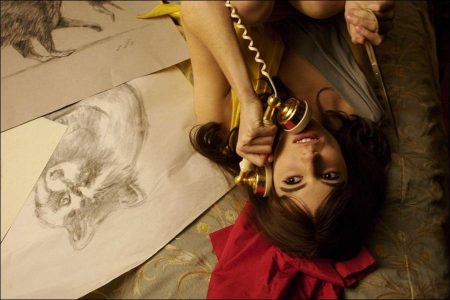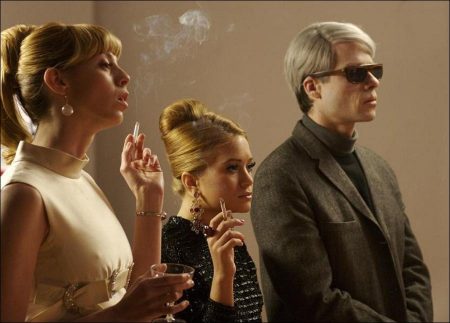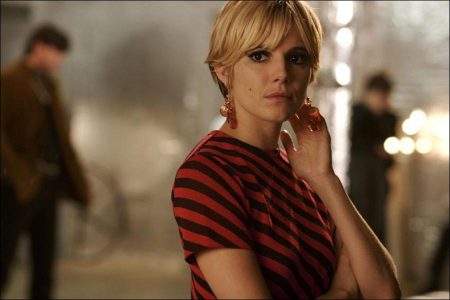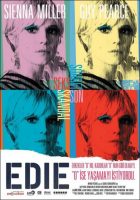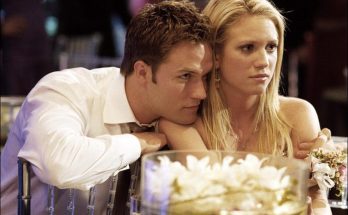It’s not entirely inappropriate that “Factory Girl,” George Hickenlooper’s biography of Edie Sedgwick, the most glamorous of Andy Warhol’s so-called superstars, should suggest a magazine layout masquerading as a film. The world through which Sedgwick blazed and burned out was one that lived and died by the camera. It existed to be seen and drooled over. But God help you if you actually lived in it.
Fueled by speed, its denizens willfully extinguished their inner lives with pharmaceuticals and put their fantasies on exhibition. In those days mother’s little helpers enjoyed a vogue as relatively harmless, energy-producing psychic rocket fuel for naughty boys and girls to stay up and party all night. We know better now.
When making a movie set in the recent past, you’re dead if it doesn’t look authentic. And the kindest thing to be said about this deluxe photo spread of a film is that Sienna Miller’s Edie and Guy Pearce’s Andy capture their characters’ images and body language with relative precision. (Mr. Pearce is much prettier than the real Warhol; if Ms. Miller doesn’t have Sedgwick’s throaty smoker’s voice and aristocratic air, she gives a furious, thrashing performance as a lost little rich girl.) The crinkled tinfoil glitter of Warhol’s East 47th Street “Silver Factory” is accurately rendered, and the actors cast as members of the Warhol entourage are reasonable physical approximations.
It’s the captions that are the problem. How do you discover the inner life of people determined to live so fast and hard that they can outrun their demons? How do you bring substance to charismatic personalities whose glamour may camouflage a void?
Clinical terms like “narcissistic disorder” may be applied to such people. But the disparity between surface and substance goes deeper than that. The trade-off between the pursuit of stardom and self-knowledge often means that when the camera is absent, there is no there there. And it’s futile to try and find one.
“Factory Girl” is structured around a 1970 therapy session for Sedgwick in Santa Barbara, Calif., where she died of a barbiturate overdose a year later at the age of 28. She is ever the whiny victim, especially of her father, Fuzzy (James Naughton), who she says sexually abused her since she was 8.
From Santa Barbara the movie flashes back to Edie’s departure from art school in Boston for the bright lights of 1965 Manhattan with her Svengali, Chuck Wein (Jimmy Fallon), who arranges her introduction to Warhol. And so the circus begins. There are brief, revised re-enactments of her appearances in several Warhol films.
In the movie’s hostile portrayal of Warhol, that pop art giant comes across as an emotional vampire who loathed his own appearance and used Sedgwick as a vicarious mirror, then turned his back when she became troublesome. The screenplay by Captain Mauzner includes none of Warhol’s deadpan oracular pronouncements about culture and art, nor any outside observations about the meaning of it all.
In its search for a story “Factory Girl” invents a spurious power struggle between Warhol and Bob Dylan (identified only as Musician because his lawyers threatened to sue) for possession of Edie’s soul. It goes so far as to imagine an idyllic affair between Sedgwick and Mr. Dylan that probably didn’t take place. (She did, however, have an affair with his close friend Bobby Neuwirth.) It seems to blame both Warhol’s and Mr. Dylan’s rejections for her precipitous decline.
In this simplistic tug of war, Mr. Dylan is the God of authenticity and inner truth and Warhol the Devil of superficiality and glitter, but you wouldn’t know it from the ludicrous mumbo-jumbo muttered by the Dylan character (Hayden Christensen). If Mr. Christensen’s rock star is too sleek by half to be a credible Dylan (there’s no dirt under these fingernails), he comes with Mr. Dylan’s accouterments of the time — a cap, a harmonica and a motorcycle — and affects a softened version of the singer’s nasal sneer. The impersonation is abysmal. The soundtrack includes no music by Mr. Dylan, whose “Like a Rolling Stone” is one of several of his songs thought to be inspired by Sedgwick. Instead we get Tim Hardin.
Edie: Factory Girl (2006)
Directed by: George Hickenlooper
Starring: Sienna Miller, Hayden Christensen, Guy Pearce, Mena Suvari, Jimmy Fallon, Tara Summers, Shawn Hatosy, Beth Grant, James Naughton, Mary Elizabeth Winstead, Illeana Douglas
Screenplay by: Captain Mauzner
Production Design by: Jeremy Reed
Cinematography by: Michael Grady
Film Editing by: Dana E. Glauberman, Michael Levine
Costume Design by: John Dunn
Set Decoration by: Cynthia Anne Slagter
Art Direction by: James A. Gelarden, Eva Radke
Music by: Ed Shearmur
MPAA Rating: R for pervasive drug use, strong sexual content, nudity and language.
Distributed by: Metro Goldwyn Mayer
Release Date: December 29, 2006
Visits: 179
